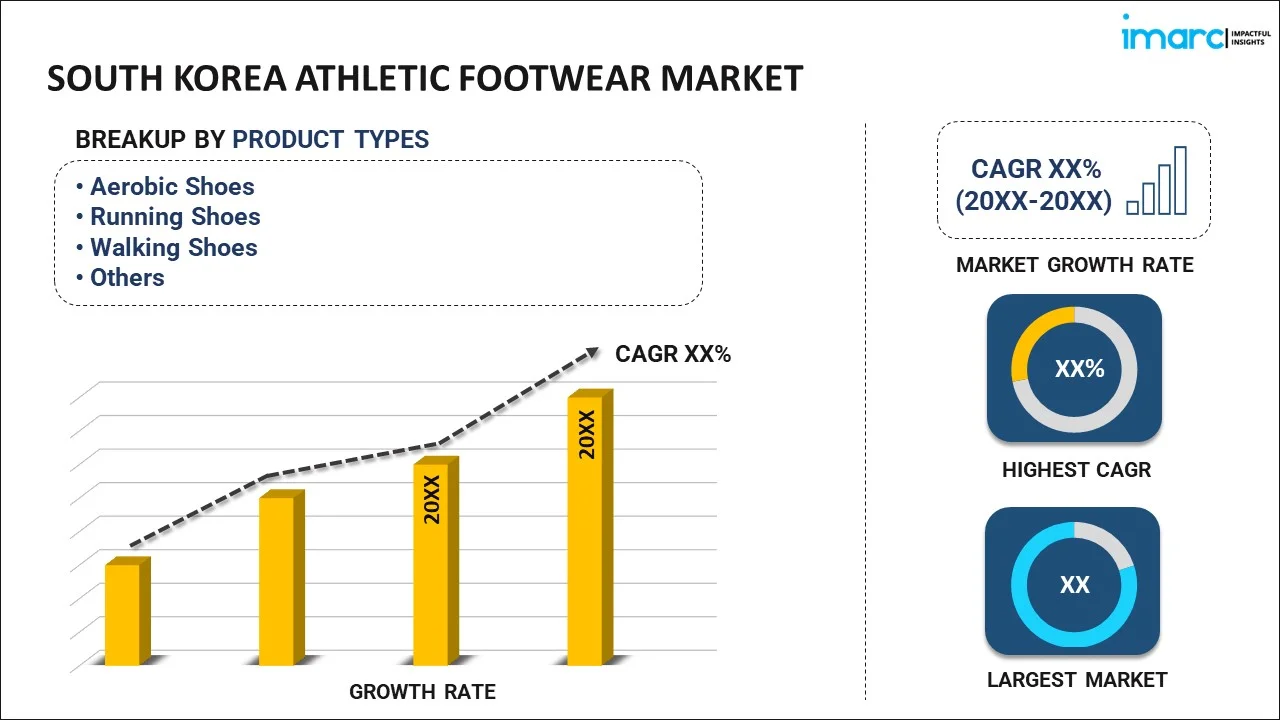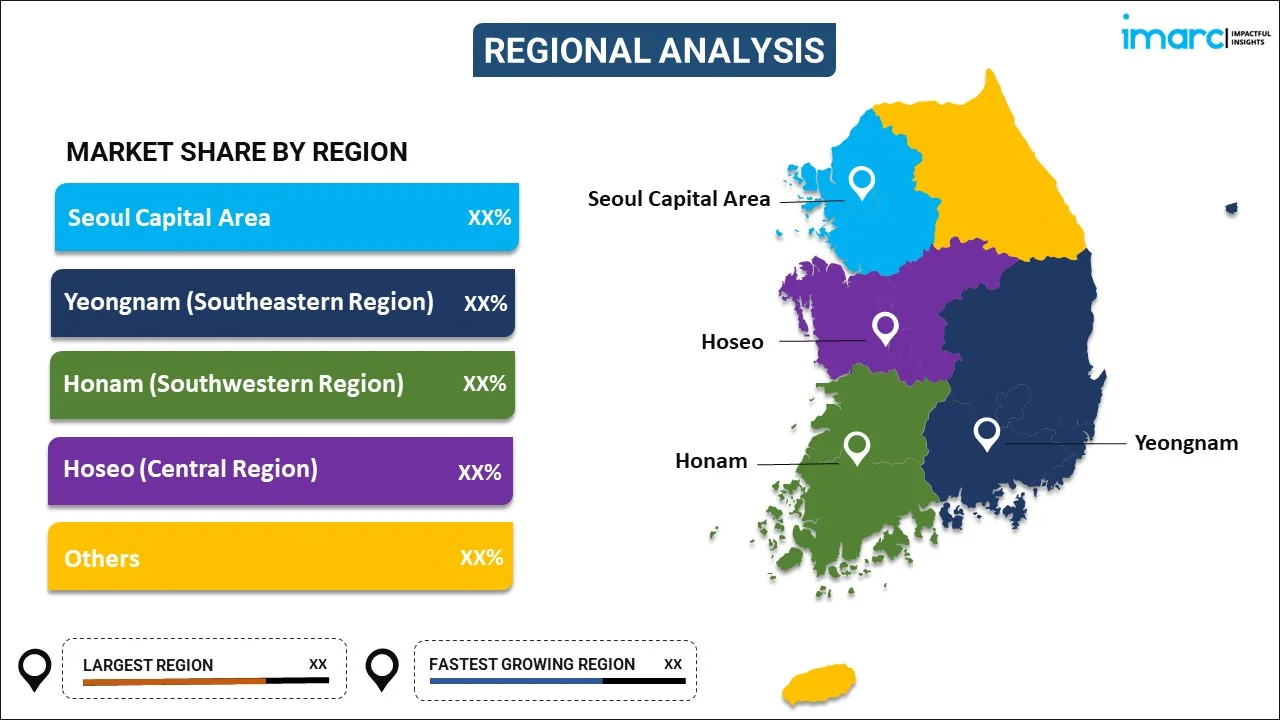
South Korea Athletic Footwear Market Report by Product Type (Aerobic Shoes, Running Shoes, Walking Shoes, Trekking and Hiking Shoes, Sports Shoes), Distribution Channel (Supermarkets and Hypermarkets, Specialty Stores, Brand Outlets, Online Channels), End User (Men, Women, Kids), and Region 2026-2034
South Korea Athletic Footwear Market Overview:
South Korea athletic footwear market size is projected to exhibit a growth rate (CAGR) of 2.69% during 2026-2034. The increasing advancements in materials and technology, such as lightweight and breathable fabrics, cushioning systems, and sustainable materials, which contribute to the popularity of athletic footwear, are driving the market.
|
Report Attribute
|
Key Statistics
|
|---|---|
|
Base Year
|
2025 |
|
Forecast Years
|
2026-2034
|
|
Historical Years
|
2020-2025
|
| Market Growth Rate (2026-2034) | 2.69% |
Athletic footwear has evolved from simple protective gear to a dynamic fusion of technology, comfort, and style. Designed to enhance performance and provide optimal support during physical activities, modern athletic shoes cater to diverse sports and fitness needs. Cutting-edge materials, such as breathable mesh and lightweight synthetics, contribute to comfort and agility, while advanced cushioning technologies absorb impact, reducing stress on joints. Brands continually innovate to address specific athletic demands, incorporating features like stability enhancements for running shoes, ankle support for basketball, and specialized traction for various surfaces. Beyond functionality, athletic footwear has become a fashion statement, with vibrant designs and collaborations between sports brands and renowned designers. The industry's emphasis on sustainable materials and manufacturing processes reflects a growing awareness of environmental responsibility. Whether for professional athletes or casual enthusiasts, athletic footwear plays a pivotal role in promoting performance, preventing injuries, and aligning with personal style preferences.
South Korea Athletic Footwear Market Trends:
The athletic footwear market in South Korea is experiencing robust growth, primarily driven by increasing consumer awareness of health and fitness. Additionally, the rising trend of athleisure wear has significantly contributed to the surge in demand for athletic footwear. Moreover, advancements in technology and innovation within the industry have propelled the market forward. Furthermore, the growing focus on sustainable and eco-friendly products has prompted manufacturers to develop environmentally-conscious athletic footwear, meeting the preferences of environmentally aware consumers. In tandem, the surge in sports participation, coupled with major sporting events, has heightened the demand for performance-oriented athletic footwear. Furthermore, the influence of celebrity endorsements and collaborations between sports brands and high-profile athletes has intensified consumer interest, fostering market expansion. E-commerce channels have played a pivotal role, offering consumers convenience and a wide range of choices. In essence, a confluence of factors, including lifestyle changes, technological advancements, sustainability initiatives, and effective marketing strategies, continues to propel the regional athletic footwear market to new heights.
South Korea Athletic Footwear Market Segmentation:
IMARC Group provides an analysis of the key trends in each segment of the market, along with forecasts at the country level for 2026-2034. Our report has categorized the market based on product type, distribution channel, and end user.
Product Type Insights:

- Aerobic Shoes
- Running Shoes
- Walking Shoes
- Trekking and Hiking Shoes
- Sports Shoes
The report has provided a detailed breakup and analysis of the market based on the product type. This includes aerobic shoes, running shoes, walking shoes, trekking and hiking shoes, and sports shoes.
Distribution Channel Insights:
- Supermarkets and Hypermarkets
- Specialty Stores
- Brand Outlets
- Online Channels
A detailed breakup and analysis of the market based on the distribution channel have also been provided in the report. This includes supermarkets and hypermarkets, specialty stores, brand outlets, and online channels.
End User Insights:
- Men
- Women
- Kids
The report has provided a detailed breakup and analysis of the market based on the end user. This includes men, women, and kids.
Regional Insights:

- Seoul Capital Area
- Yeongnam (Southeastern Region)
- Honam (Southwestern Region)
- Hoseo (Central Region)
- Others
The report has also provided a comprehensive analysis of all the major regional markets, which include Seoul Capital Area, Yeongnam (Southeastern Region), Honam (Southwestern Region), Hoseo (Central Region), and Others.
Competitive Landscape:
The market research report has also provided a comprehensive analysis of the competitive landscape in the market. Competitive analysis such as market structure, key player positioning, top winning strategies, competitive dashboard, and company evaluation quadrant has been covered in the report. Also, detailed profiles of all major companies have been provided.
South Korea Athletic Footwear Market Report Coverage:
| Report Features | Details |
|---|---|
| Base Year of the Analysis | 2025 |
| Historical Period | 2020-2025 |
| Forecast Period | 2026-2034 |
| Units | Million USD |
| Scope of the Report | Exploration of Historical and Forecast Trends, Industry Catalysts and Challenges, Segment-Wise Historical and Predictive Market Assessment:
|
| Product Types Covered | Aerobic Shoes, Running Shoes, Walking Shoes, Trekking and Hiking Shoes, Sports Shoes |
| Distribution Channels Covered | Supermarkets and Hypermarkets, Specialty Stores, Brand Outlets, Online Channels |
| End Users Covered | Men, Women, Kids |
| Regions Covered | Seoul Capital Area, Yeongnam (Southeastern Region), Honam (Southwestern Region), Hoseo (Central Region), Others |
| Customization Scope | 10% Free Customization |
| Post-Sale Analyst Support | 10-12 Weeks |
| Delivery Format | PDF and Excel through Email (We can also provide the editable version of the report in PPT/Word format on special request) |
Key Questions Answered in This Report:
- How has the South Korea athletic footwear market performed so far and how will it perform in the coming years?
- What has been the impact of COVID-19 on the South Korea athletic footwear market?
- What is the breakup of the South Korea athletic footwear market on the basis of product type?
- What is the breakup of the South Korea athletic footwear market on the basis of distribution channel?
- What is the breakup of the South Korea athletic footwear market on the basis of end user?
- What are the various stages in the value chain of the South Korea athletic footwear market?
- What are the key driving factors and challenges in the South Korea athletic footwear?
- What is the structure of the South Korea athletic footwear market and who are the key players?
- What is the degree of competition in the South Korea athletic footwear market?
Key Benefits for Stakeholders:
- IMARC’s industry report offers a comprehensive quantitative analysis of various market segments, historical and current market trends, market forecasts, and dynamics of the South Korea athletic footwear market from 2020-2034.
- The research report provides the latest information on the market drivers, challenges, and opportunities in the South Korea athletic footwear market.
- Porter's five forces analysis assist stakeholders in assessing the impact of new entrants, competitive rivalry, supplier power, buyer power, and the threat of substitution. It helps stakeholders to analyze the level of competition within the South Korea athletic footwear industry and its attractiveness.
- A competitive landscape allows stakeholders to understand their competitive environment and provides an insight into the current positions of key players in the market.
Need more help?
- Speak to our experienced analysts for insights on the current market scenarios.
- Include additional segments and countries to customize the report as per your requirement.
- Gain an unparalleled competitive advantage in your domain by understanding how to utilize the report and positively impacting your operations and revenue.
- For further assistance, please connect with our analysts.
 Request Customization
Request Customization
 Speak to an Analyst
Speak to an Analyst
 Request Brochure
Request Brochure
 Inquire Before Buying
Inquire Before Buying




.webp)




.webp)












